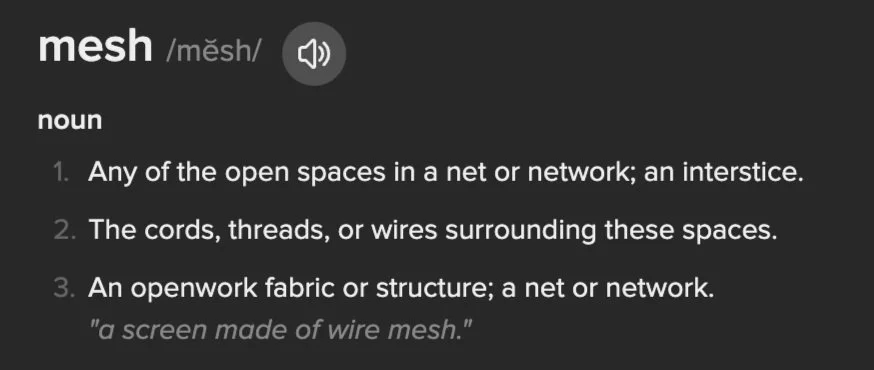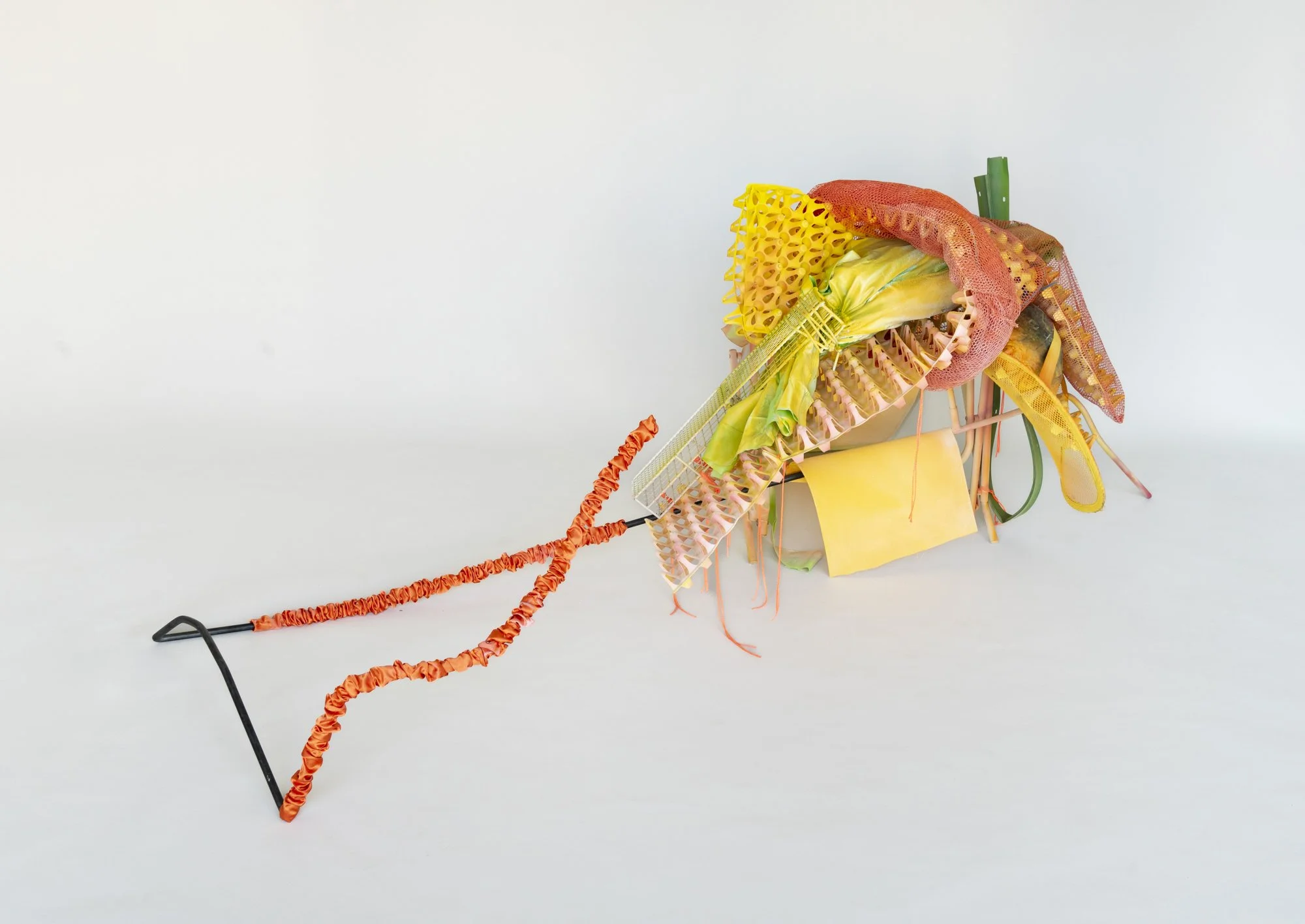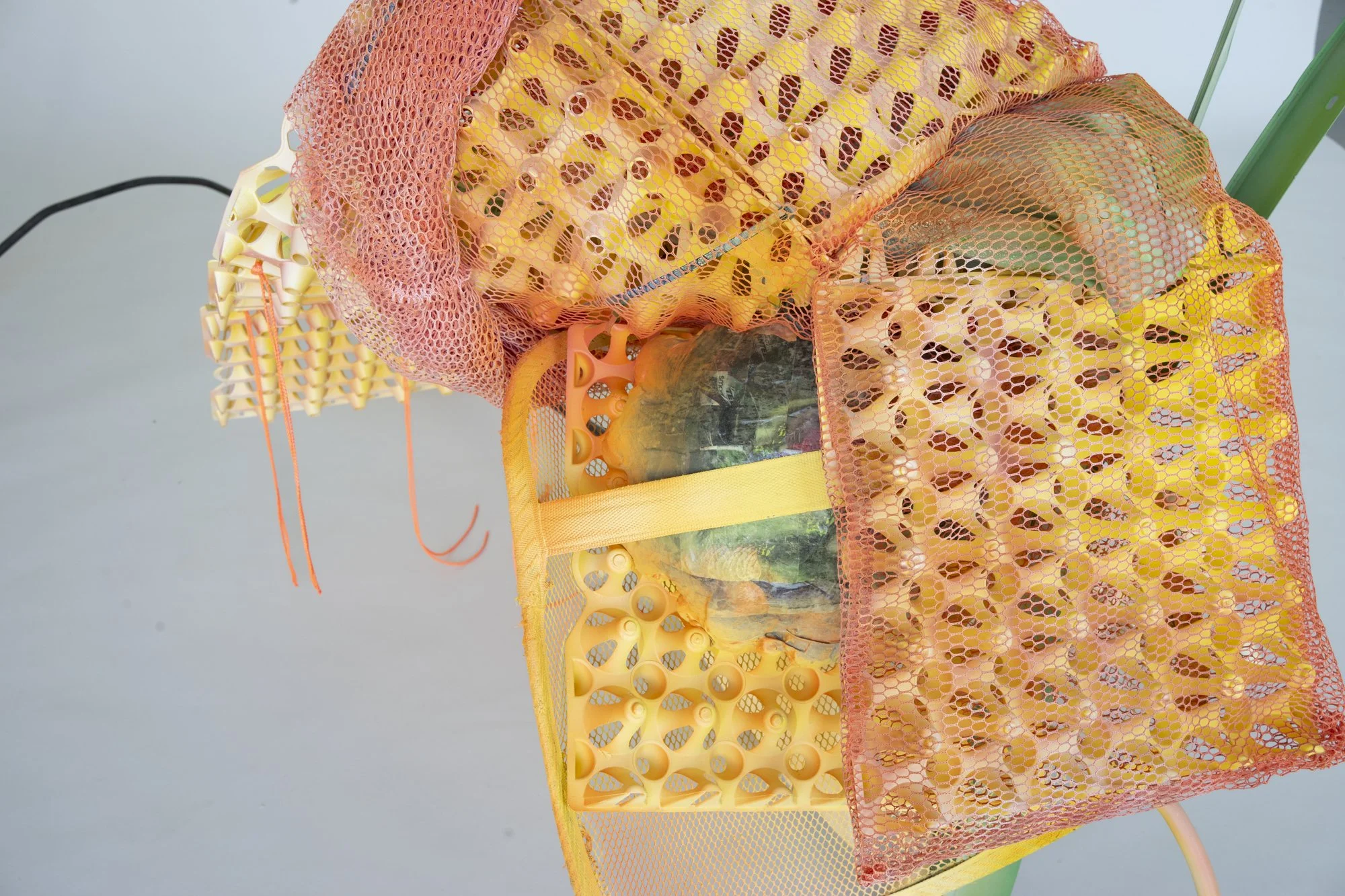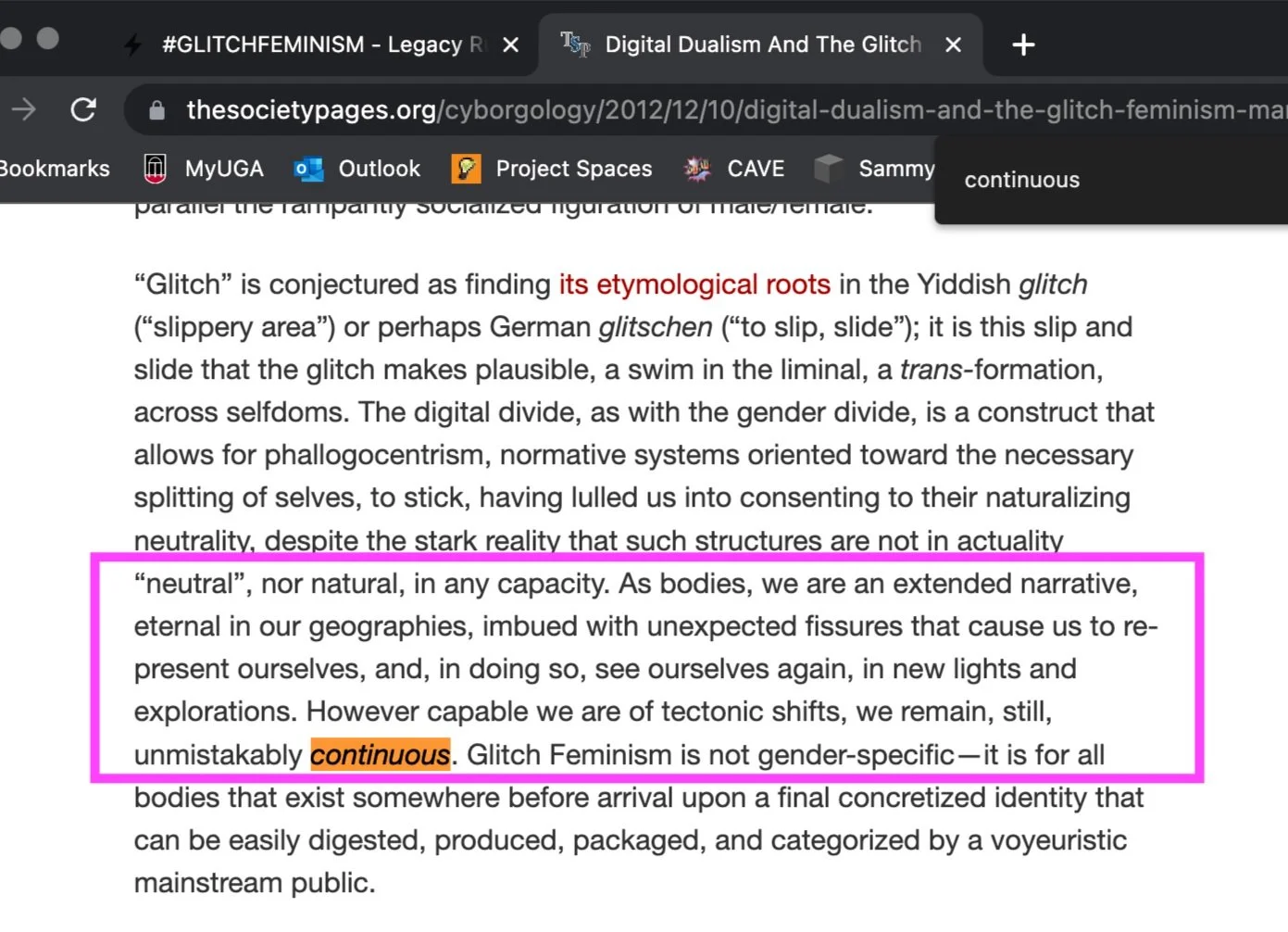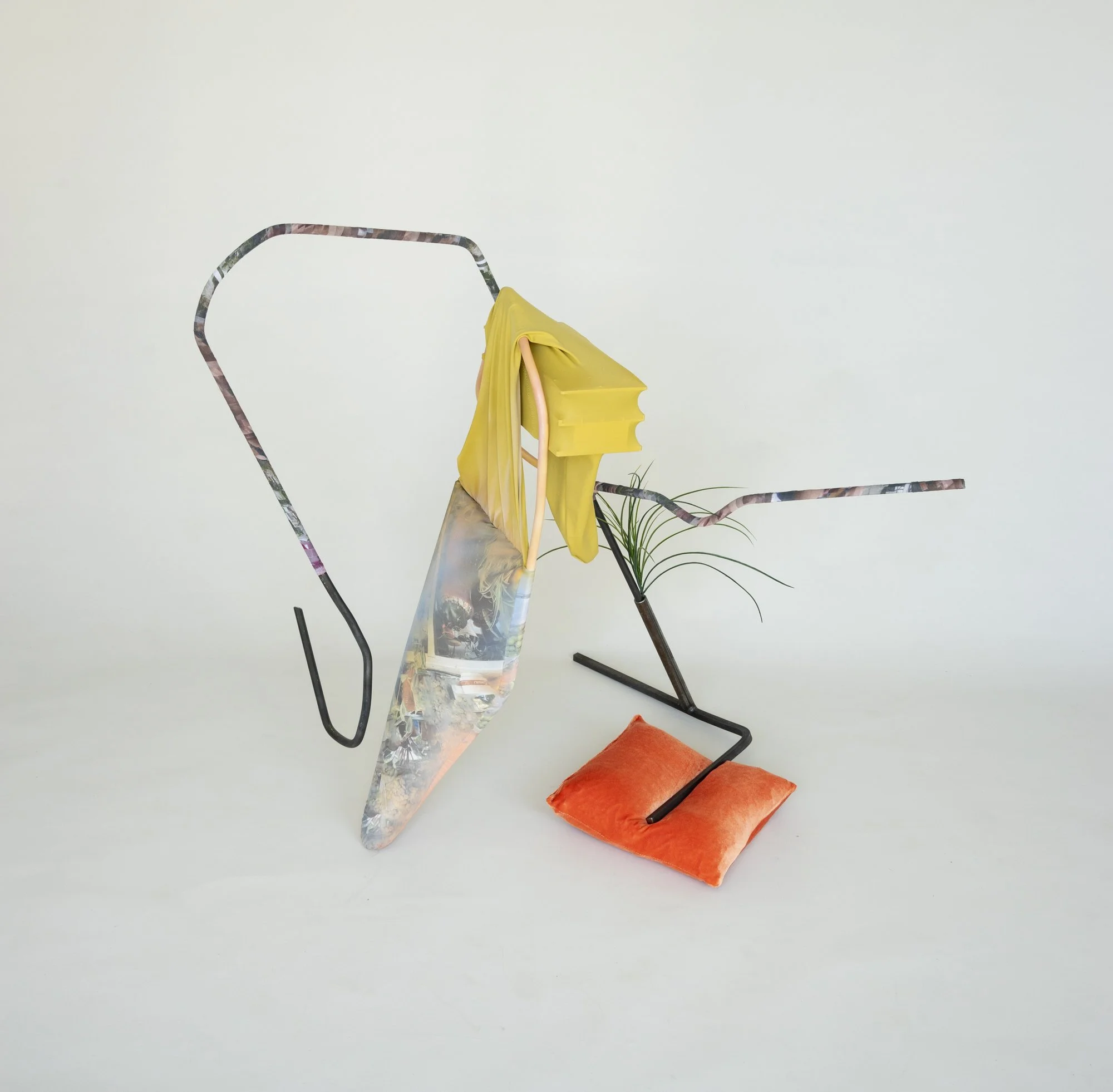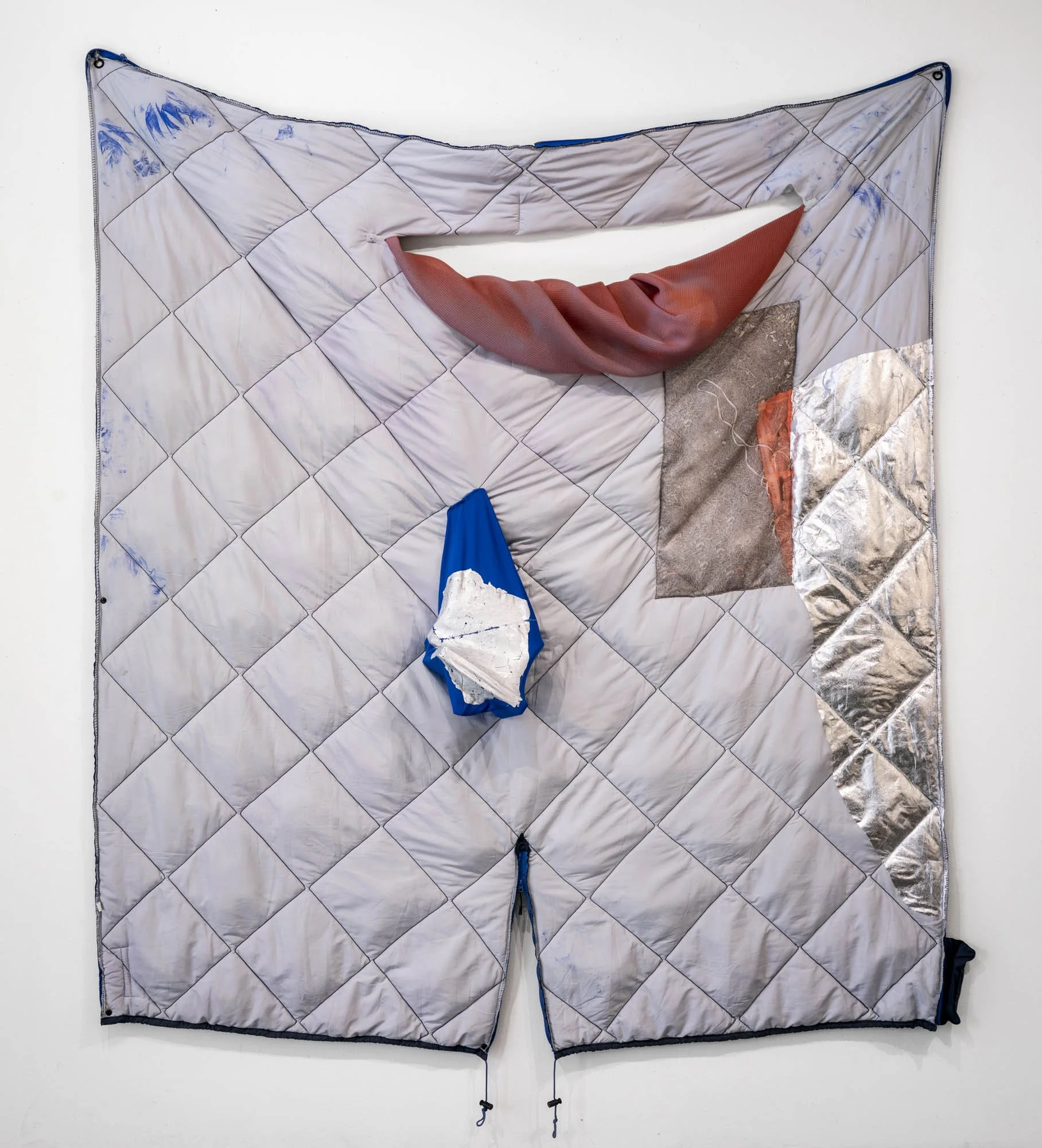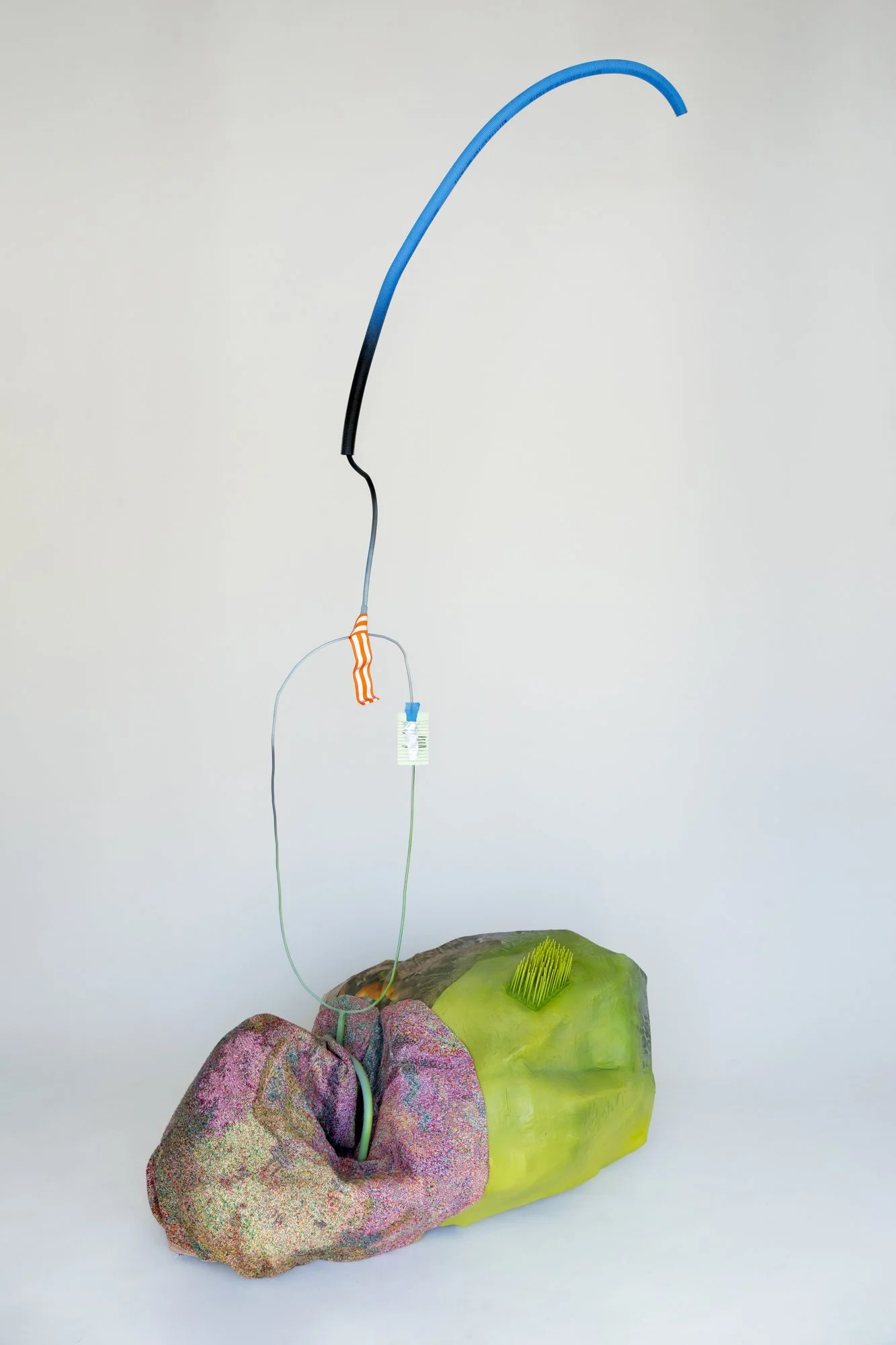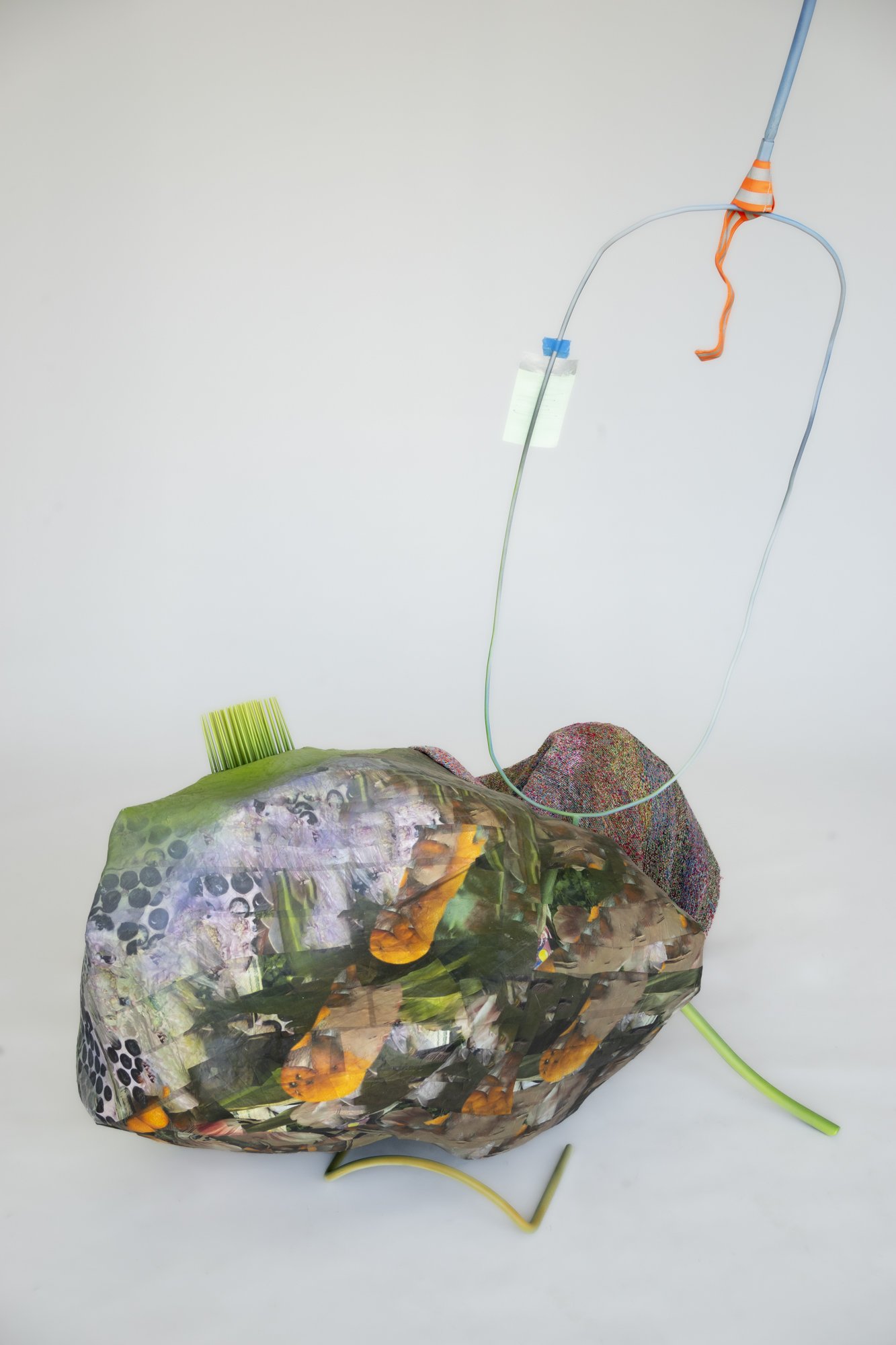What Knots Knot Knots
“It matters what matters we use to think other matters with; it matters what stories we tell to tell other stories with; it matters what knots knot knots, what thoughts think thoughts, what descriptions describe descriptions, what ties tie ties. It matters what worlds make worlds, what worlds make stories.”
–Donna Haraway, Staying With The Trouble: Making Kin in the Chthulucene
I entered grad school considering filters. As we collectively muddled our way through the mire of 2020 and 2021, I spent 40 hours a week staring at multiple monitors while working in the chaos of a pandemic-fueled tech boom. Living alone, nearly everyone was outside my physical reach (1). I drank Facetime coffee with my partner and cooked Facetime dinner with my best friend. We are all familiar with that time’s pang of distance. With so much interaction flowing through screens, the shape of our relationships shifted. I began to think about what got caught in the pixels. What is obscured and what comes through? In what ways does technology make us hungry? How does it invite our vulnerabilities? While I’ve always been interested in interpersonal dynamics and social spaces, I started to examine the mediation of interactions and think about them materially.
Mesh and enmeshment, networks, the web, (dis-)orientation and multi-dimensionality–I keep coming back to terms that slip between theories of material, sexuality, and digital interaction. The repetition of these terms interests me; it draws out our tendency to use media as metaphor, frameworks for how we think about the structures we inhabit and embody. As I pursue a fluid and multiple (il)logic, the theoretical connections I’m making between subjectivity, queerness, and the digital network may be more resonant than computational. Slipperiness is intentional, and poetry is welcome. The slip allows for thinking beyond linear order, discrete categories, binaries, and “hard” data. It brings a tendency for subjects to never be quite contained. It undermines the hierarchy of mastery to suggest a model of knowledge that is multi-directional and searching.
1. The metaphor now embedded in my brain comes from a poem written by my friend and collaborator River Wharton - “Digital touch feels like pancakes in the morning w/o syrup.”
Textile as Medium
I engage a variety of materials in my practice (works on paper, found objects, airbrush painting, scraps, wire, and steel), but I keep returning to textiles for their qualities of interrelation. Fabric involves intimacy and contradiction. Simultaneously decorative and functional, it can carry saturated commercial colors or printed photographs, its yardage ready to be sewn into a sack or a blanket. Daily wear and use draws cloth close to the body. It protects but often only just, a soft barrier draping around the form it covers. Its touch is as defining as its visual surface; the quality of friction offers constant sensory experience, and over time, the material carries traces of that contact.
Through merging the visual and the tactile, textiles achieve a form of interdimensionality. They provide a channel to consider how a material structure emphasizes or truncates the senses of the body. I’m reminded that fabric is a “medium” beyond the term’s relevance to fine art and the physical objects that I’m making. It fulfills Marshall McLuhan’s definition of a medium as something that “extends human capacities” (2). Textiles emphasize the protection of our skin; they enhance our capacity to hold and expand the exchange of self-expression with community and culture. Though fabric is by no means a new technology, its role as a mediator relates to the contemporary actions of digital technology. With these considerations in mind, I offer textile qualities–porousness, drape, and stretch–as entry points to the network of ideas in my practice. Each physical behavior emphasizes a mode of relation and extension. Together, they unsettle the understanding of an object (or an individual) as a closed and stable whole.
2. McLuhan, Understanding Media.
Porous
Mesh
Eve Kosofsky Sedgwick describes queerness as “an open mesh of possibilities, gaps, overlaps, dissonances, and resonances, lapses and excesses of meaning where the constituent elements of anyone’s gender, of anyone’s sexuality, aren’t made (or can’t be made) to signify monolithically.” Sedgwick’s “open mesh of possibilities” calls to mind the slippage of enmeshed, a metaphor that comes up persistently in contemporary discussions of digital media, social relation, and ecological thinking. Though cultural buzzwords risk losing meaning, in this case the diverse application appropriately reflects the ethic built into the metaphor. Mesh indicates not only networked connection across non-linear points but an aspect of dynamic openness. The first hit in my search for “mesh definition” provides a satisfyingly succinct breakdown of mesh’s porousness, highlighting the contradictory nature of a material equally defined by its gaps as by its matter.
There is an active relationship between the interstices, the fibers, and the network formed by the interacting parts of the structure. Rather than passively receiving the ambient environment, mesh integrates with its context (air/light/flowing water/digital chatter/etc.), engaging in a constant shifting of information and influence. Though the fabric could be seen as planar, permeability and exchange eclipse the duality of sides.
Tenuous Screen (2021) offers early seeds of the material-conceptual connections that my current work proposes around enmeshment. Combining a cut chiffon grid with the rigidity of wire mesh, it gestures towards poetic relationships around porousness and instability, formulated through consideration of physical materials and their manipulation.
Folland, Robert Rauschenberg's Queer Modernism, 349.
The American Heritage Dictionary of the English Language, 5th Ed.
Tenuous Screen, 2021
Tenuous Screen’s muted gray chiffon glints with an occasional fluorescent haze, cascading from the hot red-orange edge of the wire mesh shelf supporting it. Digitally planned and laser cut, the fabric grid is precise yet fluid. Its lines waver with a distorted skew that appears to be falling, and the light material responds to any change in ambient airflow: an open door or the disturbance of a passerby. The hardware mesh and chiffon mimic each others’ gridded structure, but with different levels of resistance and fluidity. The wire’s gaps are plainly evident, while the fabric’s open weave is shown by its translucency, then magnified by the laser cut design. Overlapping threads and wires create coherent yet permeable surfaces. Each material demonstrates its relation to my hand and to the environment, with the shelf’s imperfect bends echoing the textile’s intentional skew. When the fabric flows with moving air, this too heightens its sense of responsiveness, its status as a porous structure.
The material overflows and, in a way, undermines itself; at least “itself” as a stable and self-sufficient whole. Like Sedgewick’s queerness, mesh’s structure includes “gaps… lapses and excesses.” This is a generative incoherence, producing change and new interactions within the system as well as in exchange with the system’s context. The openness of the form create conditions of possibility (3).
3. “Conditions of possibility” come up in Olga Goriunova’s writing on digital commons and Tom Conley’s discussion of “The Fold,” though the significance of open potential is implied more widely in much of the queer and digital theory I reference. This idea will return as I look at multiple (material and conceptual) forms of relationship and instability.
The Reach of Possible Positions
Conditions of possibility do not aspire to specific outcomes or even to resolution generally. They are neither utopian nor doomy. Rather, they acknowledge continuous variation that involves re-understanding the (spatial and temporal) bounds of an object, a subject, or a system. To borrow from Dorion Sagan’s description of the body, “As an organism’s connections to the external environment grow, that environment becomes its body… the boundaries of selfhood are expanding… Because the self is not closed but open–for the relation of the elements of physiological identity and physiological subjectivity link up with all matter through all of time…” (4).
Playsuit System For the Swamp, 2024 (detail)
While Sagan’s writing about porousness focuses on the biological body, I can’t resist seeing the way that this dynamic–the self is not closed but open–echoes a wider understanding of subjectivity’s multiplicity. We are enmeshed with our environments, with each other, and with the technologies through which we produce and consume information. An incomplete and perhaps obvious list of some of these technologies: books and libraries, the electrical grid, highways, online message boards, wrist watches, and the mobile web. All of these systems include specific (non-neutral) conditions for interaction and expression. Through shared technology, we perform versions of ourselves; the ways we identify and self-represent respond to the forum (dating app, group text, newsletter, Linkedin, finsta). We inhabit ever-accumulating subject-positions.
Rather than framing human experience in terms of individuals or stable subjects, “subject-positions” point to the myriad instances of iteration in the always-ongoing process of becoming. In her writing on digital commons (5), Olga Goriunova describes the relational implications of this instability. The influence flows in both directions.
The relations are multidirectional, and so… by creating a certain subject position, a re-formulation of a cut of the world takes place. The subject position is not only produced but produces–practices, environments–which, in turn, trickle further away…Once a subject-position, a point-of-view, a techno-cultural gesture is established, it travels: in networks, in space-time, in methods, in disciplines, in politics, in imaginaries.
The collectively-created, digital archives that Goriunova discusses emerged from Web 1.0, made up of websites offering information rather than social interaction. By adding information to the web and re-organizing already-present knowledge, wikis and similar sites demonstrate subject-positions that influence the actions of users. For instance, a wiki may shape a “virtuoso forager, able to find results where there are none and follow their interests in constructing a wide range of knowledge frameworks.” The sites offer models of understanding while building in an openness for continued change.
Though this model of website as open archive still exists (both newly created and as evidence of early html’s enduring functionality (7)), the way that we relate to and inhabit digital space has significantly shifted. With the introduction of social networks and our near constant immersion in online interaction, the process of collective knowledge formation now overflows individual sites. We have moved from a technology landscape in which our digital engagement happened at a keyboard apart from activities “in real life” (IRL) to one in which that divide has disintegrated. We exude simultaneous communication across messaging, reactions, and comments; we absorb news (of friends, of war, of celebrities, of politics) via infinite scroll and rapid fire video content–all while inhabiting a physical body that might be cooking dinner or standing next to a friend who is also looking at their phone. I’m interested in the contradictory overwhelm that this simultaneity may evoke, and I’ll later return to its friction of dis/connection. But here, I mean to say that, for better or worse, we are enmeshed. The self is not closed but open. As sensing, expressing, perceiving beings, the reach of our bodies has become diffuse.
4. Sagan, “Metametazoa: Biology & Multiplicity,” 379.
5. To illustrate the idea of digital commons, Goriunova discusses early web “shadow library” projects such as the Temporary Autonomous Zone (TAZ), Aaaarg, and Custodians.online that worked to make PDF texts and other media freely accessible, through the open and collaborative labor of amateur librarians. “Shadow libraries and repositories…are non-state, no profit archives, precarious libraries, public knowledge ecosystems that form new types of culture and knowledge commons. These radically open knowledge infrastructures are unstable, ephemeral, inventive commons, whose subjects see and make the world differently.” - Goriunova, “Uploading our Libraries,” 41.
6. Goriunova, 60-61.
7. The realization that websites endure is somehow both obvious and surprising. What millennial hasn’t gone searching for their middle school MySpace page to glimpse that earlier version of themself? While watching designer Mindy Seu’s discussion with Legacy Rusell, I was struck by Seu’s intentional use of html 1.0 and default web fonts to make the Cyberfeminist Index continually functional through future technological changes. Anticipating the labor of technology-related maintenance, Seu leverages the web’s foundational elements as the basis for a site that can remain open, continuing to change and grow. I also want to credit that discussion between Seu and Russell for the idea of using citations and footnotes to disrupt linearity.
Tactile
Drape
Where mesh complicates the perception of a material’s binary plane, drape demonstrates a quality of possibility through cloth’s varied response to its situation. It imposes gravity upon the specific arrangement of a material and what forms it touches. Touch. Influenced by the makeup and organization of a textile’s threads (8), drape indicates interaction between internal structure, weight, and any objects interrupting the falling fabric. Drape is anti-rigid. It says we are situated and shifts with the shifting of a body.
As it folds in on itself, drape generates a dynamic interiority. The fold relies on proximity; inside and outside double over and come into contact (9). As described by Gilles Deleuze, the fold illustrates the complex relationship of orientation, embodiment, and subjectivity (10). While the material (and the self) remains continuous, its form comprises multiple, shifting orientations. Attempting to unfold always reveals another pleat.
There is a queer quality to the fold’s unsettled touch joining inside and outside. In Queer Phenomenology, Sarah Ahmed describes the reciprocal aspect of orientation–we are shaped by the spaces that we reside in, and we shape the spaces we share (11). Instances of touch respond to each other and unveil new arrangements. To illustrate the point, Ahmed proposes a queer chair as one that doesn’t just receive us comfortably. As we fidget, it fidgets back, and we become aware of the background in dynamic relationship to our body. The queer object generates contact (or an awareness of contact) where we might otherwise not think to consider proximity. In the post-internet age where many of our interactions are mediated by screens (12), however, the question of proximity is not straightforward. Constant digital connection operates as a sixth sense extending our body’s reach while often keeping us at physical distance. This contradiction requires evolving our understanding of closeness.
Digital closeness is our cloud-shared grocery list updating on both our devices. It is the intimacy of my personal data mashing against yours when we’re in the same room, so that I receive your targeted ads when we walk away. It is the ability to sustain intimate relationships across multiple states; our text threads are pictures of our faces, their kids, heart reactions and ooooohs interspersed with blocks of text thick with slower needs and vulnerability. Coming into adulthood with the mobile web let our connections shift with multiple moves; and reciprocally, the structural continuity of those relationships may have given me range to wander. The shape of intimacy responds to the vessel. The chair fidgets back. I notice myself phrasing self-expression in the short-form text of a social media caption, not-quite complete sentences that give up personal pronouns in favor of description and exclamation–good colors; still so tired; today’s lump report; WOW that sax; love you though. Push alerts ping over professional emails and lethargically swiping apps (13). The distracted immediacy of response and the reach of closeness fold together.
8. "The intimate relationship between warp and weft directs the behavior of the resultant cloth. Reciprocally, the required behaviour of the woven cloth dictates the selected warp-weft relationship. Behaviour and structure flow in and around one another.” - Dormor, A Philosophy of Textile, 65.
9. Conley, “Folds and Folding,” 174.
10. Deleuze’s theory of the fold (based in Liebniz and the Baroque) is a pool I could dive deeper into. There is something distinctly queer about the fold’s Baroque excess. And there is something relevant about the curvature of Baroque perspective as an alternative to our “logical” Cartesian paradigm. I want to relate it to Hito Steyerl’s “In Free Fall” (discussed later in this essay). Both provide reminders of how visual culture and media structures shape our ordering of the world. Consider this note a bookmark for future expansion, not intended to contain the topic at hand but to indicate further connections still forming.
11. “Bodies may become orientated in this responsiveness to the world around them, given this capacity to be affected. In turn, given the history of such responses, which accumulates as impressions on the skin, bodies do not dwell in spaces that are exterior but rather are shaped by their dwellings and take shape by dwelling.” - Ahmed, Queer Phenomenology, 9.
12. Not to mention the influence of ever-accumulating personal data generated by transactions, location services, and proximity to the devices of the people around us.
13. A lesson in containing multiplicity: Remember to turn off desktop text notifications if presenting from your laptop.
Material Touching
By now, I hope it is clear that I do not mean for the textile qualities I’ve been discussing to stay squarely in their lanes. Whether addressing the materials themselves or their theoretical associations–the integration of mesh, the touch of drape, the tension of stretch–these aspects intertwine with each other. I have taken them apart in an attempt to illustrate themes contributing to my work’s conglomeration, but, in practice, they compound to form a network / a constellation / a subject position.
In the studio, I incorporate metal armatures with found plastics and various versions of mesh, disparate materials bound together with twine and zip ties, the meeting points obscured by fabric and blurred by airbrush gradients. I’m attracted to materials that have ambiguous familiarity. Livespaced Me Watching Me Watch You Watching Me (2024) splays open a twisted plastic cornucopia shoved-through with a lime green pool float and propped on the discontinued limbs of a commercial lawn chair. Recalling both still life and figure, the form lounges low; it stretches out a line of steel rod, slumping to meet the floor as if accepting the weight of a body. The steel’s hard structure is partially disrupted by its covering of scrunched satin–a slightly gaudy dress-up, a safety orange zip, an umbilical cord, or an intestine.
Livespaced Me Watching Me Watch You Watching Me, 2024
I question the nature of specific meetings between physical components (Does the peeled-back netting reveal or entrap?) while attempting to let the larger whole exceed my own understanding. I might also call this uncertainty, permission for the work to exist between stable positions. My formal choices pursue this quality in contemplation of the conglomerated instability of queer subjectivity and digital space. The work is not about the internet or even necessarily about queerness, but it is about the ways of knowledge that can be found through these lenses. (Knowledge that is whole yet will remain incomplete; lenses that offer knots rather than clarity; knots that twist the straight lines of reason to reveal that they’ve always been twisted.) Though the contemporary norms of digital interaction often encourage coherent self-representation (14), the underlying system involves potential for sudden change and reversal, unresolved errors and non-linear iteration. We can re-represent and contradict our previous selves through a structure that is in many ways made up of contradictions.
As my podcast feed keeps reminding me (15), social media is contributing to the United States’ current crisis of loneliness while the interactivity of web 2.0 offers a haven of community support for marginalized identities who may otherwise find themselves isolated (16). Algorithms maximize attention by reinforcing user preferences, serving up content similar to what we’ve already viewed and screening out the unpleasant experience of divergent viewpoints. Like the touch of a garment custom made to measure, the algorithm’s repetitive contact may feel comforting or even supportive. But the homogeneity also leads to radicalization and dissociation. Digital interaction involves all these dynamics at once, prompting simultaneous experiences of liveness and lethargy, distance and connection. The dissonance produces one sort of friction (17). Moments of rupture in the system–the glitch, the dead link, the text message disrupting an infinite scroll–produce another type of friction. They expose the interface; paths meant to be parallel begin to cross (18).
In her writing on the glitch, Legacy Russell proposes that a disruptive pause in the dominant system opens up the ability to see that the system is in fact not “neutral.” Connecting with race, feminism, and sexuality, Russell aligns the errors of online experience with fissures in self-understanding that prompt reconsideration and re-presentation. “However capable we are of tectonic shifts, we remain, still, unmistakably continuous” (19). In the glitch’s framework, breakdowns become integral to the structure. This points to queer theory’s broader adoption of failure (20) as a site for re-definition–not in the hopes of a perfect resolution, but in embracing conditions of possibility. My recent sculptures lean into formal and dimensional hybridity as a way to interrogate the in-betweenness of becoming, a process that incorporates what we’re in contact with yet maintains outlines of past and potential future iterations. We are never fully synthesized.
I Want to Be Lush Like Plastic Trees, 2023
14. I'm referencing the self-branding of Instagram influencers (which is maybe waning with the decline of the hyper-curated millennial aesthetic) but also Facebook's demand for "real" names and websites prohibiting users from credential sharing or switching between multiple accounts. Legible markers of gender, race, and location enable targeted marketing, and in order for companies to most effectively monetize our data, we must concentrate our engagement in single accounts that correspond with the presumed-stable truth of our AFK identities. This is less true in online communities that normalize avatars and alter-egos (gaming sites and forums, for example) in connection to play, humor, or sexual expression.
15. https://www.nytimes.com/2023/04/18/opinion/ezra-klein-podcast-sheila-liming.html
16. I’m not suggesting cause and effect, but the availability of online queer community and visibility feels connected to the increase in adults self-identifying as LGBTQ: https://news.gallup.com/poll/611864/lgbtq-identification.aspx.
A significant portion of this increase comes from the bisexual portion of the spectrum, which pop culture has often framed as indecisive, attention-seeking, or an in-denial midpoint on the way to same-sex-only attraction. Beyond the impact of the internet content making queer identities more visible, inhabiting various digital spaces provides room to play with how one’s identity is expressed and named (whether through pronouns, avatars, or chosen handles). Across platforms, these multiple expressions exist at once.
17. I have to acknowledge that digital media’s negative aspects are much more complex than I can do justice to in this essay. Here are few readings on our contemporary media landscape that I found insightful:
New Dark Age: Technology and the End of the Future - James Bridle
Never alone, except for now : art, networks, populations - Kris Cohen.
Digital Lethargy - Tung-Hui Hu
18. Ahmed, Queer Phenomenology, 169.
19. I first read Glitch Feminism in 2021, in the period where I was working remotely and anticipating grad school, dating online and finding words for my own experience of queerness. The simple yet specific permission to be continuous through tectonic shifts felt like a deep exhale. This text provided a foundational influence in coming to the connections I’m now making in my research.
20. Oakley, The Gender Fail Reader and https://en.wikipedia.org/wiki/The_Queer_Art_of_Failure, the latter of which is in my stack of to-be-read PDFs that will keep this research going. This pairing of sources demonstrates my research tendency to seek out contemporary sources that bring black, trans, and non-binary perspectives to canonical texts. Because of the speed of cultural change around queer and digital theory (as well as the more recent availability of non-white, non-cis perspectives), I often work my way backwards.
Friction
Stretch
Friction and resistance are informative even when uncomfortable. Alone, drape is too ease-full. It caresses gently. Objects and bodies in drape’s path hinder it only lightly as the material flows over the surface. I’ve used that lightness of touch in works such as Tenuous Screen and Twin Realms, letting the materials almost hover as a way to make space for the viewer’s relation and perception. However, as I consider the friction of embodied experience, I want to allow the work a certain amount of tension. Sag and stretch impart force upon a draped textile, shifting the focus to the meeting between cloth and the resisting objects (21).
Though I incorporate textiles into my work in a way that abstracts their explicitly functional use, I still rely on the material’s associations with human contact. We use fabric to adorn ourselves and our homes, to carry our possessions, to protect fragile objects, and to create banners of celebration and protest. Textiles touch the body, and the body pushes back (22). The rub of sensing skin against tactile surface allows us to differentiate silk’s liquid slide from rough canvas. We cannot feel a surface without pressing on it.
Softy, 2023
21. Instances of resistance: the imprint my socks leave on my ankles, oranges sagging in their matching plastic mesh, unseen objects trapped in blue spandex, tugging the collar of your shirt before it rips.
22. “[Cloth is] the most tactile of surfaces, always in contact with skin and body it carries the contradictory meanings of being an external surface turned outward towards the gaze of the viewer, while remaining forever proximate...Textiles continue to bear the connotations of the tactile even when they are not worn or made explicitly for bodily contact. A wall hanging, a tapestry, a ritual artifact for symbolic use… nevertheless connote the tactile as an implicit meaning.” - Pajaczkowska, “On Stuff and Nonsense: The Complexity of Cloth,” 54.
Softy (2023) plays with the exchange of tension and release. Ribbons of chiffon cascade over the edges of the peach pedestal, its sliced segments responding to the room’s air flow. Even at rest, the image jitters. A texture of blue denim stretches into pink skin and back again. You catch snatches of eyes and teeth, but the coherence melts apart, gently grotesque.
Incorporating printed fabric with a welded steel armature, the sculpture represents my work’s move from airy wire forms to more sturdy and physically present structures. Softy’s veiny channels seem to be in motion. The work is almost anxious, leaning to one side as if mid-shift, with lines that reach outward while constrained by a tube of yellow fruit mesh. Standing back, the mesh is haze, more holes than material. Coming closer shows an ambiguous relationship. Have the noisy lines been trapped in an attempt to restrain, or is the sculpture in process of growing this new skin? She is off-balance and in-between, suspended in disorientation.
The potential of disorientation comes up repeatedly in queer theory, asking what types of worlds emerge when we shift the “given” away from settled alignment. Like many of the ideas that I keep returning to, disorientation engages with contradiction. Just as the glitch jolts us into awareness of technology’s dominant structure, disorientation puts us back into our body by disrupting its usually smooth sensing. Since orientation is always relational, it’s worth asking what we’re disoriented from and what we’re straining against. The rupture from a presumed “neutral” is both vital for opening new ways of being and can involve very real harm. Be Oakley describes this entanglement of tension and possibility in their writing on trans and nonbinary bodies failing to meet cultural demands for stable and coherent gender identities. “As queer subjects, we often contradict ourselves, simply by changing, growing, navigating and existing in transphobic and racist systems… A body can be much more than its physical form; it can be a thought, an aspiration, a futurality, a not-quite-there-yet. A queer body isn’t always fully realized” (23). The disoriented body is still processing. The content of possibility is inherently undefined, but the dynamic of possibility is the point. By imposing distance between perceiving and understanding, disorientation forces us to consider if it is our own perspective or the systems we inhabit that are off kilter. And evading alignment means we keep reconsidering. My recent works seek moments of material and perceptual friction to suggest a not-quite-there-yet; the momentum has not completed its arc; the gaze will multiply; the heavy lean may yet fall.
23. Oakley, The Gender Fail Reader, 24-25.
Unstable Images
Uncertainties of bodily touch and visual perspective emerge in the constellated elements of Soft Trap (New Skin and Hyperobjects). Made of a sleeping bag splayed open, the gray quilted interior at once offers a blank matrix and a vaguely grimy reminder of the object’s previous use. It sags on the wall, seeming to have trapped the objects that it presents. A blue spandex sack pulls at the quilted grid; the same saturated color smudged around the sleeping bag’s edges recall a grappling touch. Is the quilt the body, or has it been cast off by the body it used to hold?
Soft Trap (New Skin and Hyperobjects), 2023
Repeated use of color, silver leaf, and printed photographs generate visual connections, but a sense of dissociation persists. We encounter the body mid-metabolization. On the right hand side, silver leaf extends the edges of photographed pine needles and orange safety fencing. It’s a ghost of the object cropped out of view yet more physically present in its materiality. With the vertical stance and imperfect resolution, the photo evidently comes from a phone’s camera roll. The viewer gazes down at the ground, suggesting their own feet just beyond the frame. Another photo floats, skewed, off to the left (blurry blue sky over a suggestion of hands and legs, the gathering of a picnic). The sight emphasized in Soft Trap layers multiple gazes, shifting upwards and down, bound to touch by an object that can fold, expose, and wrap around the subject.
In On Free Fall: A Thought Experiment on Vertical Perspective, Hito Steyerl suggests that we are living in a new visual paradigm of technology that moves sight beyond a single and stable body. She offers “free fall” as a perspective that shatters the assumption of linear order and standing on solid ground. Digital media’s images are unstable, embedding the user in fragments, repetition, and overlaps. Pictures may be AI-generated deep fakes or decontextualized misrepresentations of current events; they may be viral memes accumulating into a sort of folk knowledge as they circulate; they may offer speculation and fabulation, depicting potential alternatives that don’t yet exist.
My use of photographs in sculptural work reaches for this decentralized and non-linear instability. We inhabit a visual culture, and the images pulled from my phone’s camera roll appear to offer concrete references to daily life (bodega shelves full of plants, the half-eaten spread at a backyard birthday party, habitually-walked ground beneath my feet) (24). The clarity of the photographs shift, though, through digital and material manipulation. Sometimes treated as surface, sometimes as object, their dimensionality becomes ambiguous. Soft Trap’s printed chiffon initially looks like a window to the other side of the hanging textile. But the fabric is translucent against the quilt’s grid, and puffy lines show through the needle-covered ground.
Perspiring in Just as the Welcome Of, 2024
In Perspiring in Just as the Welcome Of (2024), fragments of blueberry pie and tulips cover the visual surface of a boulder-like base (large enough to sit upon or crawl inside). The image collages in my current work come out of layering iPhone photos and pushing Photoshop’s AI tools to the point of incoherence. I ask the algorithm to guess what should fill an empty space but only provide inadequate fragments of the original image. Through repeating this action, speculation overtakes the source. In this case, the boulder’s collage fades into green paint, like a partially-rendered model. A woven blanket oozes onto both surfaces, but its commercial picture is turned inside, instead showing a glitched and over-saturated inversion. Perched on top, a mirror-like oval frame projects upwards into the reach of a blue tube.
Seen together, the actions of each surface and form are truncated. The oval asks what is reflected or changed through the portal. The spurting blue line cuts off before realizing its full arc. Photos and green paint blur together, unclear which is turning into which. Perspiring buffers without moving towards resolution.
24. Plants and fruit repeatedly show up in my phone roll. Though I haven’t yet gone down this research path, I suspect that the initial attraction has to do with lush objecthood (saturated color, waxy skin, bitten insides), excess, and ecological thinking (another interconnected network).
Unfinished
The poet Ada Limón has described poetry as recognizing wholeness without an imperative for summary or solutions, suggesting that “to give answers would be to disrespect the gravity of the questions.” While many aspects of our tangible, logistical existence demand solutions, uncertainty opens potential. It carves out space to simultaneously live within and resist the complex friction of culture. To co-opt Judith Butler’s words on gender performativity, we must use imperfect strategies “to work the trap that one is inevitably in.” Our contemporary trap includes the incessant contact of post-internet media culture. It includes performing sexuality and gender while dwelling in a body. It includes the enmeshment of our social relationships, whether through digital interfaces or impressions of skin.
Although we have always been interconnected–affected by and affecting our environments and each other–the digital network makes the enormity of these connections insistently visible. Because the network is both collective and live, it continues to amass and change. We dwell in relationships and in instability. Bringing these digital dynamics into conversation with queer theory inflects them with conditions of possibility. The glitch of disorientation does not have to move towards resolution. My practice investigates these slippery structures built upon intentionally shifting ground. In the connections made, I hold the shimmering contradiction of subjectivity maintaining unfinishedness while re-defining continuously. Objects and bodies become interdimensional through exceeding understood forms. Each excess generates potential new ways of being, and each rupture invites us to think uncertainties.
25. https://onbeing.org/programs/ada-limon-to-be-made-whole/
26. Butler, “The Body You Want.”
27. “The network is the best representation of reality we have built, precisely because it too is so difficult to think… it is nonlocal, and it is inherently contradictory - and this is the condition of the world itself.... Thus the network, properly understood, can be a guide to thinking other uncertainties; making such uncertainties visible must be done precisely so that they can be thought... In the face of atomisation and alienation, the network continually asserts the impossibility of separation.” Bridle, New Dark Age, 76.
Bibliography
Ahmed, Sara. Queer Phenomenology: Orientations, Objects, Others. Durham: Duke University Press, 2006. https://doi.org/10.2307/j.ctv125jk6w.
Bridle, James. New Dark Age : Technology and the End of the Future. London: Verso, 2018.
Butler, Judith. “The Body You Want.” Interview with Liz Kotz. Artforum, November 1992
Conley, Tom. “Folds and Folding.” In Gilles Deleuze : Key Concepts, edited by Charles J. Stivale, 170-181. Second edition. Oxon, England: Routledge, 2014.
Deleuze, Gilles, and Jonathan Strauss. “The Fold.” Yale French Studies, no. 80 (1991): 227–47. https://doi.org/10.2307/2930269.
Dormor, Catherine. A Philosophy of Textile : Between Practice and Theory. London ; New York: Bloomsbury Visual Arts, 2020.
Elkins, Amy E. Crafting Feminism from Literary Modernism to the Multimedia Present. Oxford ; Oxford University Press, 2022.
Folland, Tom. “Robert Rauschenberg’s Queer Modernism: The Early Combines and Decoration.” The Art Bulletin 92, no. 4 (2010): 348–65. http://www.jstor.org/stable/29546136.
Goriunova, Olga. “Uploading our Libraries: the Subjects of Arts and Knowledge Commons.” In Aesthetics of the Commons, edited by Cornelia Sollfrank, Felix Stalder, and Shusha Niederberger, 41-63. Zurich: Diaphanes, 2021.
Haraway, Donna Jeanne. Staying with the Trouble : Making Kin in the Chthulucene. Durham: Duke University Press, 2016.
Klein, Ezra and Sheila Liming. “The ‘Quiet Catastrophe’ Brewing in Our Social Live”. Produced by Annie Galvin. The Ezra Klein Show, April 18, 2023. Podcast, MP3 audio, 76:08. https://www.nytimes.com/2023/04/18/opinion/ezra-klein-podcast-sheila-liming.html.
Langlois, Ganaele. “Textile, the Uneasy Medium.” In Re-Understanding Media: Feminist Extensions of Marshall Mcluhan, edited by Sarah Sharma and Rianka Singh, 68-84. Durham: Duke University Press, 2022.
Limón, Ada and Krista Tippett. “To Be Made Whole”. Produced by The On Being Project. On Being, February 16, 2023. Podcast, MP3 audio, 71:40. https://onbeing.org/programs/ada-limon-to-be-made-whole/.
McLuhan, Marshall. Understanding Media : The Extensions of Man. New York: Signet, 1964.
Nelson, Maggie. On Freedom : Four Songs of Care and Constraint. Minneapolis, Minnesota: Graywolf Press, 2022.
Oakley, Be, and Noah LeBien. The Gender Fail Reader: Texts by Be Oakley & Noah LeBien, Ed. 1. Brooklyn: GenderFail, 2021.
Pajaczkowska, Claire. “On Stuff and Nonsense: The Complexity of Cloth.” In Textiles : Critical and Primary Sources, Volume 4 : Identity, edited by Catherine Harper, 47-69. English ed. London ; New York: Berg, 2012.
Russell, Legacy. Glitch Feminism : a Manifesto. London: Verso, 2020.
Sagan, Dorion. “Metametazoa: Biology & Multiplicity.” In Incorporations, edited by Jonathan Crary and Kwinter Sanford, 362-385. New York, NY: Zone, 1992.
Sedgwick, Eve Kosofsky. Tendencies. Durham: Duke University Press, 1993.
Sharma, Sarah, and Rianka Singh, eds. Re-Understanding Media : Feminist Extensions of Marshall Mcluhan. Durham: Duke University Press, 2022.
Steyerl, Hito. “In Free Fall: A Thought Experiment on Vertical Perspective.” e-flux Journal, April, 2011.https://www.e-flux.com/journal/24/67860/in-free-fall-a-thought-experiment-on-vertical-perspective/

